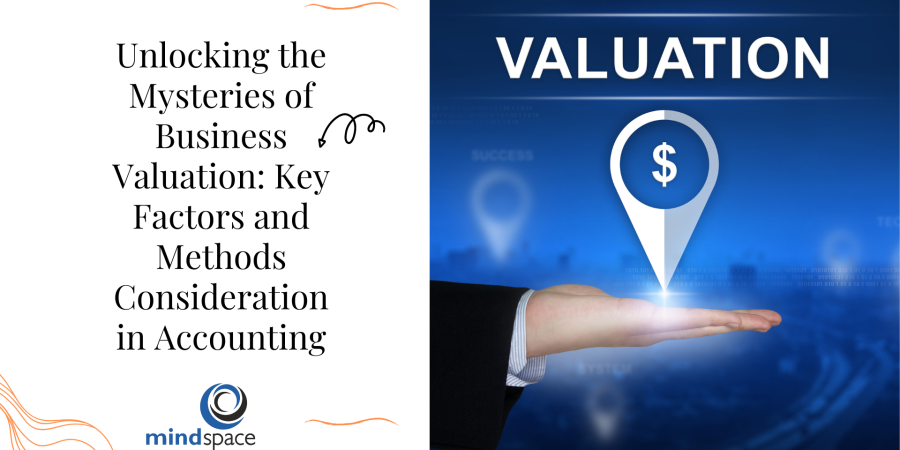Unlocking the Mysteries of Business Valuation: Key Factors and Methods Consideration in Accounting
Introduction
In the dynamic landscape of business, understanding the true worth of a company is essential for investors, stakeholders, and decision-makers alike. Business valuation is a complex process that goes beyond mere financial statements and requires a comprehensive analysis of various factors. In this blog, we will delve into the intricate world of business valuation, exploring the key factors and methods considered in the realm of accounting.
Key Factors in Business Valuation
- Financial Performance
One of the primary considerations in business valuation is the financial performance of the company. Investors and analysts scrutinize financial statements, including the income statement, balance sheet, and cash flow statement. Revenue growth, profitability, and liquidity are key indicators that provide insights into the company’s operational health.
Profitability ratios such as net profit margin and return on equity are critical metrics, offering a snapshot of how efficiently the business is generating profits and utilizing its equity. Strong financial performance is often an indicator of a company’s ability to weather economic uncertainties and attract potential investors.
- Market Conditions
The economic environment and industry-specific conditions play a pivotal role in business valuation. A company operating in a thriving industry with high growth potential may be valued more than a similar business in a stagnant or declining sector. Analysts assess market trends, competitive landscape, and overall economic conditions to gauge the potential risks and opportunities that could impact the company’s future performance.
- Industry Comparisons
Comparative analysis is a fundamental aspect of business valuation. Investors and analysts often compare a company’s financial metrics with industry benchmarks to evaluate its relative performance. Understanding how a business measures up against its peers provides valuable insights into its competitive position and growth prospects.
- Intellectual Property and Intangible Assets
In today’s knowledge-driven economy, intellectual property and intangible assets play a crucial role in business valuation. Brands, patents, trademarks, and proprietary technologies contribute significantly to a company’s competitive advantage. Valuation methods that account for these intangible assets, such as the cost approach and the income approach, help determine their fair value.
- Management and Human Capital
The strength of a company’s management team and its human capital is a key factor in business valuation. A skilled and experienced leadership team can navigate challenges and capitalize on opportunities effectively. Investors often assess the quality of management, employee expertise, and succession planning when valuing a business.
Methods of Business Valuation
- Income Approach
The income approach to business valuation focuses on the company’s ability to generate future income and cash flow. Two commonly used methods under this approach are the discounted cash flow (DCF) method and the capitalization of earnings method.
The DCF method estimates the present value of expected future cash flows, considering the time value of money. This method requires careful forecasting of cash flows and determining an appropriate discount rate to reflect the risk associated with those cash flows.
The capitalization of earnings method, on the other hand, calculates the value of a business by dividing its expected annual earnings by the capitalization rate. This method provides a snapshot of the business’s value based on its current earnings capacity.
- Market Approach
The market approach involves comparing the subject company to similar businesses that have been recently sold or are publicly traded. This method relies on market-derived multiples such as price-to-earnings (P/E) ratio, price-to-sales (P/S) ratio, or enterprise value-to-EBITDA (earnings before interest, taxes, depreciation, and amortization) ratio.
By analyzing transactions or market data of comparable companies, analysts can derive a valuation multiple and apply it to the financial metrics of the subject company to estimate its value.
- Asset Approach
The asset approach values a business based on its net asset value, considering both tangible and intangible assets. This approach is particularly relevant for companies with significant tangible assets, such as real estate or manufacturing equipment.
Under the asset approach, two common methods are the going concern method and the liquidation method. The going concern method values the business as if it will continue operating, taking into account the present value of expected future cash flows. In contrast, the liquidation method values the company based on the assumption that it will be liquidated, and its assets will be sold.
Conclusion
In conclusion, business valuation is a multifaceted process that requires a thorough understanding of various factors and methodologies. Financial performance, market conditions, industry comparisons, intellectual property, and human capital are key considerations that contribute to the overall valuation of a business.
While different valuation methods exist, each with its strengths and limitations, a holistic approach that combines multiple methods often provides a more accurate and reliable valuation. Ultimately, business valuation is both an art and a science, requiring a blend of financial acumen, industry knowledge, and strategic foresight to arrive at a fair and justifiable value for a company. As the business landscape continues to evolve, mastering the intricacies of business valuation becomes increasingly crucial for investors, stakeholders, and accounting professionals alike.


